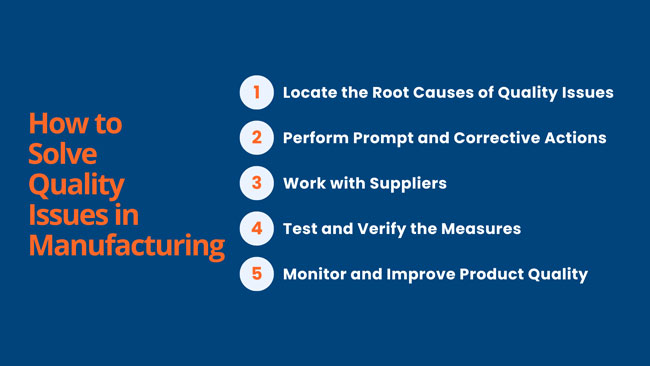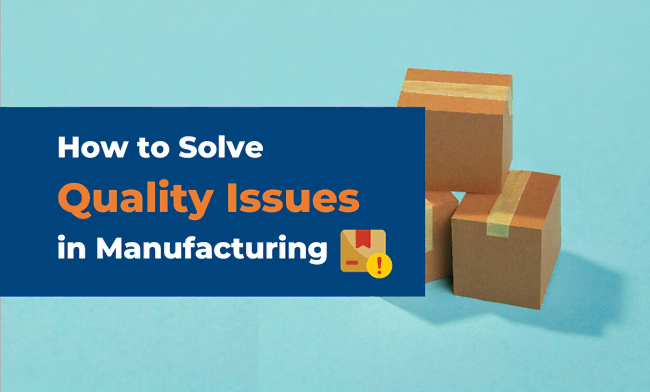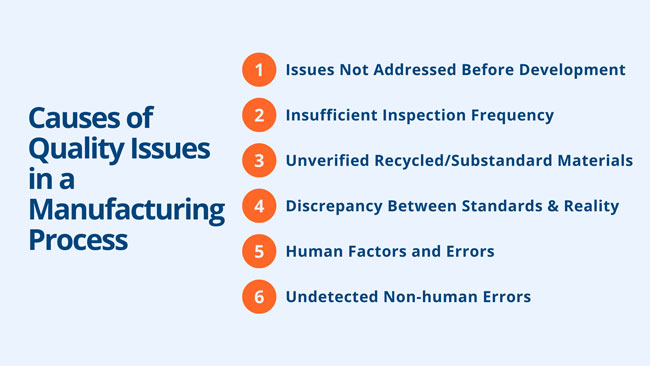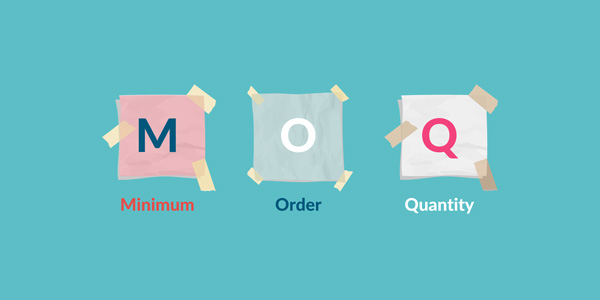How to Solve Quality Issues in Manufacturing: Step-by-Step Guide
- Date:
- Author: SVI Content Team
- Share:
Product quality is crucial for a company’s survival in a highly competitive market. No company wants to face quality issues, deal with the consequences, and risk losing customer trust.
This article delves into the common causes of quality problems and provides solutions and best practices to improve product quality. By the end, you’ll have a comprehensive understanding of product quality control, ensuring that your orders meet the highest standards.
Part 1. Causes of Quality Issues in a Manufacturing Process
Why do quality problems arise? Here are the factors you should think about.
✔ Issues Not Addressed Before Development
The phase of product development is the foundation where product quality lies. Getting the product “right” from the start saves a lot. Just like building a house, the final product is the standard pattern for manufacturers.
A precise and robust product standard and specifications play an important position in minimizing the quality issues downstream. If the inaccurate design specifications or issues haven’t been addressed before mass production, no wonder that the product quality will be affected.
❗ Common quality problems:
- Inaccurate dimensions
- Wrong quality tolerances
- Functional errors
🔍 Root causes:
- Incomplete product specifications
- Unvalidated prototypes
- Unresolved design gaps before production
✔ Insufficient Inspection Frequency
Inspections are conducted at various stages of the manufacturing process to ensure that products meet customer requirements and promptly address any identified defects. They serve as a crucial quality control measure throughout production.
However, if the inspection frequency is not appropriately planned or executed, it can result in undetected quality control issues that remain unresolved.
❗ Common quality problems:
- Packaging defects
- Missing or incorrect labeling
- Surface damage
🔍 Root causes:
Infrequent QC checkpoints during production, allowing defects to slip through
✔ Use of Unverified Recycled or Substandard Materials
In response to client demands or pressure from upper management, some companies may resort to using recycled or substandard materials in production.
However, if these materials are incorporated into the manufacturing process without thorough prior testing and validation, it becomes challenging to assess their impact on product quality. This can potentially lead to a range of quality issues.
❗ Common quality problems:
- Material inconsistency
- Premature wear and tear
🔍 Root causes:
Use of unverified recycled materials or cost-driven substitutions without testing
✔ Discrepancy Between Standards and Reality
Some businesses insist on producing products according to outdated standards even as the industry raises its quality benchmarks.
Failure of companies to adjust their production processes and technical parameters can result in products that fail to meet the new quality requirements, which can lead to unexpected product quality problems.
❗ Common quality problems:
- Non-compliance with standards
- Color mismatch
- Inconsistent finishes
🔍 Root causes:
Non-compliance with standards, color mismatch, inconsistent finishes
✔ Human Factors and Errors
Employees in a factory assembly line who are not properly trained may lack the knowledge and skills needed to perform their tasks correctly. That can cause errors during assembly.
❗ Common quality problems:
- Assembly mistakes
- Skipped procedures
- Variable output quality
🔍 Root causes:
- Inadequate training
- Unclear work instructions
- Communication breakdowns
✔ Undetected Non-human Errors
In some cases, problems encountered in production are not the result of human error, but rather problems with production equipment or technical parameters.
Equipment malfunction and insufficient maintenance are often the culprits. Overlooking machine inspections eventually yields substandard quality issues.
The above points mainly describe the common manufacturing issues that are usually encountered. Each of the causes corresponds to a link in the quality management system, and therefore, proper quality control must be carried out to ensure product quality.
Relying solely on quality inspectors or the quality management department to address these issues is insufficient. It is, therefore, critical that when implementing quality management, the control responsibility be delegated to the best position for personnel in optimal positions to ensure the overall effectiveness of quality management.
❗ Common quality problems:
- Equipment malfunctions
- Technical deviation after testing or usage
🔍 Root causes:
- Poor machine maintenance
- Unchecked calibration
- Ignoring predictive maintenance data
Part 2. How to Solve Quality Issues in Manufacturing

1. Locate the Root Causes of Quality Issues
First of all, to resolve the problems in quality, you have to find the root cause – understand WHO, WHAT, WHEN, WHERE, WHY and HOW the problems occur. Workers must report regularly, providing valuable information to help track and validate processes.
2. Perform Prompt and Corrective Actions
Take immediate action to address product quality issues once the causes are identified.
This may involve modifying processes, adjusting equipment settings, or replacing faulty components. Addressing the root causes directly helps prevent the recurrence of the problem.
3. Work with Suppliers
Collaborate closely with suppliers to get things correct if there are material or component-related quality issues.
Inform the issues with stakeholders, and tell suppliers the corrective actions and quality requirements clearly to work together to enhance outcomes.
4. Test and Verify the Measures
After implementing corrective measures, test and verify their effectiveness.
Conduct thorough testing and inspections to ensure that the quality issues have been fixed and that the desired quality standards are consistently met.
5. Monitor and Improve Product Quality
Lastly, establish a robust quality monitoring system to continuously track and evaluate product quality. A high-quality production needs to be meticulously monitored at every step.
Learn from resolved issues and implement continuous improvement initiatives, such as process optimization or technological advancements, to enhance product quality over time.
Part 3. Case Study of Quality Control Issues
Here are some small case studies about companies facing quality issues during manufacturing and the measures they took to solve the problems:
Case 1: Black Spot Issue on Car Parts
Problem:
A manufacturer of car parts used a new material named ABS (750SQ) for their plastic parts. However, the finished parts exhibited numerous black spots, rendering the product substandard. This resulted in significant losses for the company as the parts had to be scrapped.
Cause:
The root cause was identified as insufficient testing of the new material before use, failing to identify potential issues under various conditions, such as exposure to heat, pressure, and different levels of humidity.
Solution:
- MATERIAL TESTING PROTOCOL: The company implemented a rigorous material testing protocol for all new materials, including comprehensive analysis and evaluation under various conditions.
- SUPPLIER COLLABORATION: Worked closely with the supplier of the ABS (750SQ) to understand the cause of the black spots. The company analyzed the material’s manufacturing process, storage conditions, and transportation methods, and finally discovered that black spots were caused by microscopic impurities in the raw material that were not visible during the initial inspection.
- QUALITY CONTROL INSPECTION: The company strengthened the quality control inspection process for all plastic parts, ensuring they met the required standards.
- PROCESS ADJUSTMENTS AND AUTOMATION: To minimize the risk of black spots appearing in future production runs, the manufacturer implemented proper handling and storage procedures for the ABS (750SQ) material to prevent contamination. They also invested in automated inspection systems to ensure consistent quality control.
Case 2: Miscolored Fabric on Clothing
Problem:
A comfort apparel manufacturer received complaints about miscolored fabric in their new line of pyjamas.
Cause:
The root cause of the uneven color distribution was traced to a faulty dye batch that was not properly mixed, resulting in uneven color distribution.
Solution:
- HALT PRODUCTION: The manufacturer immediately stopped production of the pajamas with the incorrectly dyed fabric and also pulled all remaining stock from their warehouses and retail partners.
- DYE BATCH ANALYSIS: The team analyzed the faulty dye batch and the dye mixing process to identify the specific mixing error that led to the uneven color distribution.
- NEW DYE BATCH: They ordered a new dye batch from a different supplier and implemented stricter quality control measures and new dye mixing protocol for proper color consistency.
- CUSTOMER EXCHANGE: The business offered to exchange the miscolored pajamas for correctly colored ones and also issued a public apology to customers.
Part 4. Best Practices for Product Quality Control
Want to ensure high-quality production? Product quality control is an integrated process involving design, production, process control, and quality management.
Below, we’ll introduce what you can take to control the quality of products.
1. Design Phase Determines Product Quality
Establish precise specifications during product design to prevent defects in the subsequent production process.
The product’s direction is primarily set during the design phase, and quality control begins here.
2. Quantitative Process Control and Traceability
Employ quantitative and traceable methods to control and manage every detail in the production process.
3. Patiently Address Issues and Identify the Root Cause
Conduct thorough research and analysis from various angles to pinpoint the exact point of deviation, and persistently address it.
Hastily altering the production process might merely mask the problem rather than genuinely resolving it.
4. Preventive Mindset
Aim for prevention rather than post-issue rectification.
By monitoring and recognizing early signs, one can prevent the occurrence of quality issues.
5. Management Perspective
It’s essential to draw experiences from various aspects like personnel, machinery, materials, methods, environment, and measurement, and continuously refine and enhance process control requirements.
6. Listening to Opinions and Suggestions
Actively seek and consider feedback from various sources.
Outsiders often have a clearer perspective, and their insights can introduce new viewpoints and approaches, helping identify potential manufacturing issues and areas for improvement.
7. Implementation of Measures
Identifying and resolving issues doesn’t mark the end of quality control efforts.
Translate plans into action through training, audits, and accountability at critical checkpoints.
8. Spot Checks
To reduce quality defects in manufacturing, establish a spot-check plan to periodically verify and assess the implementation of product quality control measures.
Continuous quality checks in manufacturing are the keys to maintaining product quality.
Part 5. FAQs about Product Quality Issues
Q1. Why Quality Is Important in Manufacturing?
Quality in manufacturing isn’t just about making a good product; it’s about building a foundation for success. Quality defines the essence of a product. It directly influences how well a product performs its intended function and its durability. A product lacking in quality is like a fragile structure, easily susceptible to breaking and disappointing customers.
Beyond product performance, quality mirrors every aspect of a company’s operations, making it closely related to brand reputation. A reputable brand gains recognition and attracts new customers through positive word-of-mouth. Consistently delivering high-quality products can earn trust and loyalty from customers, which builds a strong brand image.
Q2. Is Product Quality Produced or Inspected?
Firstly, production precedes inspection. Only after a product is manufactured can it be inspected. Without a product, inspection is moot, let alone determining its quality. Hence, production is proactive, while inspection is reactive.
The notion that “product quality is produced, not inspected” was initially confined to quality inspection in the early days of quality management. However, merely relying on post-production checks cannot guarantee product quality.
Quality assurance is achieved only when every step of the production process strictly adheres to the production techniques and operational guidelines. Ignoring process control and solely depending on inspection won’t elevate product quality.
Quality inspection can only weed out defective and substandard products, not enhance inherent quality. Therefore, the emphasis on quality control should be during the manufacturing phase.
Q3. How Much Do Quality Problems Cost a Company?
According to the American Society for Quality (ASQ), the cost of quality problems typically consumes 15 to 20% of sales revenue for many organizations, with some reaching 40% of total operations.
This includes prevention, appraisal, internal failure, and external failure costs.
Critically, neglecting quality management doesn’t just inflate inspection budgets; it also lets you pay the price for the hidden costs like customer attrition, brand erosion, and production delays.
Learning how to improve product quality in manufacturing is a profit-protection strategy that safeguards both your bottom line and market reputation.
Conclusion
Quality control stands out as a cornerstone that determines a product’s success and a company’s reputation. Leaving quality issues unsolved causes more harm than good. The product quality problems come up due to many causes but they can all stem from the carelessness of quality control standards.
This blog has listed out the potential reasons for quality issues and given you the ways to solve them properly. As we learn all these, a far-sighted, comprehensive approach to quality management is indispensable. From the initial design phase to the final spot checks, every step requires meticulous attention and continuous refinement.
As the market evolves and consumer expectations rise, those who prioritize and master quality control will undoubtedly lead the way, setting benchmarks for others to follow.
Guarantee Product Quality with SVI Global
At this juncture, it’s worth noting that SVI Global has been at the forefront of supply chain management for over 20 years. With countless projects under our belt, we possess the expertise and experience to address quality control challenges professionally and effectively.
We are committed to ensuring that our clients’ orders are delivered to their utmost satisfaction. If you’re seeking a partner who understands the nuances of quality control and can guarantee exceptional results, look no further than SVI Global. Let us be your trusted ally in achieving excellence.










